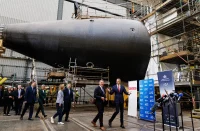Part I, II, III, IV, V, VI, VII, VIII
Centrifugal Store Of Electrons
Another factor, which enforces the positive and neutral air particles in the craft’s center, is the toroid’s pulsing magnetic field. When this magnetic field is momentarily generated it expands far out into the air surrounding the craft, and by Lorentz force, any negatively charged particle in or around the craft will be accelerated into its moving flux lines into a circulating path around the craft. Electrons will be forced by this field to spiral out from the craft and spin round this magnetic field as an external sheet of permanently excited electric energy. This Coriolis thrust upon the electrons will also exert on them a centrifugal force increasing their mass by several thousand as they spin outside the UFO (for a more detailed, and scientific, description of this phenomenon of spiralling electrons out into an external electrical sheet around a UFO (see the excellent paper “Magnetic Vortex” by Vencislav Bujic).
 Because the toroid generates both an upper and a lower pulsed magnetic field, and that the intensity of one adds to the intensity of the other, the forces upon the outward spiralling electrons will be even greater than having just one oblate spheroid field. This is where the bulk of the UFO craft’s energy is stored – it is in the form of accelerated electrons extracted from the craft and from the air surrounding it – and these sheets of energy are held outside of the craft (see fig.7 and 7a) momentarily until the toroid’s double magnetic field is made to collapse back into the center of the craft.
Because the toroid generates both an upper and a lower pulsed magnetic field, and that the intensity of one adds to the intensity of the other, the forces upon the outward spiralling electrons will be even greater than having just one oblate spheroid field. This is where the bulk of the UFO craft’s energy is stored – it is in the form of accelerated electrons extracted from the craft and from the air surrounding it – and these sheets of energy are held outside of the craft (see fig.7 and 7a) momentarily until the toroid’s double magnetic field is made to collapse back into the center of the craft.
 Inner Magnetic Ring
Inner Magnetic Ring
It was difficult to understand the purpose of the inner ring (see fig.8) from the initial descriptions of the UFO that would take Betty Luca (then Andreasson) on her nocturnal visits to an alien world, but from the details she forwarded in books like “The Watchers” by Raymond Fowler and from her own booklets “Extraterrestrial Communications – A Step Beyond Tomorrow” (Pt I & Pt II – 1999) it eventually became clear that inside this ring was a fluid formulated to energize a strong magnetic field. More especially it was used to energize a magnetic field which enlarged and re-routed the main magnetic fields of the toroid which encircled it (see figs.8a to 8c).
Briefly, in these cross-section figures it can be seen that the magnetic flux lines of the upper and lower toroid fields run parallel to the horizontal axis of the wheels of the sphere set assemblies, but in the figure 8b it shows that when the ring’s magnetic field is energized it pulls the toroid’s upper field down below the ring – to ensure that these magnetic flux lines traverse the wheels (and the arms that hold them) perpendicular to the wheel’s horizontal axis. What that means and what that does will be covered in the following section on the crystal sphere sets below after a brief description of the sphere sets.
Crystal Sphere-sets
The central rotating assembly is made up of four sphere-sets (or three sphere-sets (see fig.9), which will work just as well for the effect they produce is just the same, as will be seen below held equally spaced in a metallic plate or disc.
The base disc is formed in such a way as to fit inside the perimeter of the circular inner lower edge of the toroid, so as to be able to rotate freely with the sphere-sets (but to possibly form an electrostatic coupling with the charges on the lower edge of the toroid). This base disc also has a small diameter emission hole, of about six inches, at its center; and it may or may not be advantageous to have this base disc made of a non-magnetic metal – to create eddy currents from the lower magnetic flux lines of the toroid. Between the small upper sphere and the large lower sphere is a hollow stem made of aluminum or grey metal, smooth-curved, that looks as if it might be made of corrugated aluminum. Extending out from these stems are arms made of hollow aluminum tube which hold on an axle a glass or quartz wheel that is free to rotate. This stem with arms and the two spheres and the wheel (see fig.9a and 9b).
is what I refer to as the sphere-set, and which Betty Luca describes as ‘machines’ (in reference to their ability to hover in the air of their own accord when detached from the main body of the UFO, with a mechanism that is probably hidden inside the aluminum stem that, is not wholly relevant to the fundamental function of these sphere-sets and their interaction with the electric fields of the toroid when they remain located inside the craft. This extra ability of the sphere-sets awaits further detailed research if necessary).
The arm and wheel of each of the four, or three, sphere-sets locates the whole central assembly in the toroid’s central cavity and the wheels, resting on the inner ring, allow it to turn along the inner concave wall of the toroid so that (all) the sphere-sets attached in the base disc can be rotated about a vertical axis on an even plane – as one assembly.
The construction of the wheels and arms holding them is truly ingenious, and once again the most recent descriptions of them (see fig.9a above) afford a much improved understanding of how they work… for inside the glass/quartz wheels are radial wires or metal rods and when they line up perpendicular to the toroid wall they will form a path of electrical conduction, from the charged spheres through the metal arms to the electrical charges accumulated in the fluid inside the toroid. That those rods or wires have a specially shaped terminal at their peripheral ends is indicative of a charge-focusing devise, probably needed to concentrate the charge into a narrow beam that will penetrate through the toroid wall to allow conduction to take place. Further, when conduction does take place, and that flow of electrons creates its own magnetic field around the arms and the wires/rods of the wheel that magnetic field will react against the magnetic flux lines of the upper and lower toroid fields, and by Lorentz force (see fig.10a) (and fig.10b, 10c for an alternative configuration) the whole sphere-set will be moved sideways around the inside walls of the toroid.
This is where the magnetic field created by the inner ring comes in; as mentioned above (and in fig.8a to 8c) when the toroid’s magnetic flux lines are in their normal position those flux lines run parallel to the arms and the conducting rods inside the wheels – hence no Lorentz force and no sideways movement of the central sphere-set assembly, but when the fluid inside the ring is energized and pulls down the toroid’s upper flux lines below it the whole central sphere-set assembly rotates – just like an electric motor.
From the illustrations extracted from Betty Luca’s books (of fig.9a and 9b above) and from her descriptions (see fig.11) it can be seen that the ETs took the trouble to look at the basic qualities of an albeit mundane material such as quartz and doctored it so as to achieve the result they required… this is most evident in what they have done with the glass/quartz spheres used in this UFO craft. A glass or quartz sphere treated even as a semi-conducting dielectric will not allow electric charge to permeate into, and accumulate in, the body of the quartz to any great degree – the effect of quartz oscillating electric charge is well known but it won’t hold charge and be of any use in this circumstance. But, these large glass or quartz spheres, and possibly the small top spheres also, are specifically constructed with conducting rods or wires embedded into them so that electric charge can conduct into the sphere along the conducting wires/rods to a core zone that can be made to become a positive-polarity ‘sink’ for pulses of electrons to be drawn to.
What the exact configuration of those wires/rods are cannot be determined from the drawings available, but the process of establishing a positive ‘sink’ are; ie, through dielectric absorption – dielectric absorption is when the dielectric has a current applied to it, to polarize the structure of molecular interfaces of positive and negative charge, but when the applied current is reduced to nothing the positive charge, of the charge carriers, tends to move so slowly that for all intents and purposes they remain stuck, and so when the next ‘pulse’ of an electric charge comes in it compounds upon the previous unmoved charge, and so on and on, hence the accumulative effect which carries on pumping in more and more charge. (See for example Dielectrics P.J. Harrop (1972) pp71; Electrostatics – And Its Applications A.D.Moore (1973) p122; R.Kohlrausch Ann. Phys. Vol 91 (1854) p56-82, p179-214.).
If the metal inserts are of radial configuration then the effect on the negative electric charge might be as a non-uniform electric field (of inner positive terminal with an outer negative terminal) whereby electrons will continually migrate toward the positive core and accumulate there, with the aid of the metal conductors and the capacitive effect from the surrounding positive dielectric. Possibly this is how large amounts of electrical energy could permeate into them and store until they were discharged wholesale at a given moment. The electrical charging of the lower spheres is, of course, from the negatively ionized diffuse layer at the lower edge of the toroid.
In addition to this electric charge accumulating function of the spheres there is a further mechanism, just by looking at the process of turning the sphere-set assembly (as described above), that allows some of this accumulated electric charge to leak through the sphere-set arms and wheels into the neutral area of the surrounding toroid (see fig.12); for as in an electric circuit the neutral potential is mid-way between the positive voltage and the negative voltage, but in this case a transfer of charge into the neutral area of the toroid would presumably increase the potential difference between the negative and positive areas – and by the capacitive effect make the diffuse layers more energized.
Through the aluminum stems between them the large lower spheres are used to transfer electric energy into the small upper spheres, for, as in electrostatics if two spheres, one large and one small, are inter-connected by a conductive link so that both spheres are at the same potential, then the intensity of charge on the small sphere will be much greater than that of the large sphere (i.e. density is inversely proportional to radius of curvature). Another important, and recent, discovery about these upper and lower spheres is they both revolve, about the vertical axis of the stem; presumably to ensure that when electric current is conducted by them that current is spread round the whole circumference of the sphere so as to induce a uniform magnetic field around them. Both spheres rotate at different speeds.
Transverse Magnetic Field
When the upper small sphere, from its electrical connection to the charge accumulating lower sphere, saturates with a high enough density of negative electric charge the insulating effect of the air between it and the positive diffuse layer of charges rotating above the toroid inside the craft will breakdown and all the negative charge accumulated in each of the lower spheres will flow up around the outside surface of the sphere-set stems, over the upper spheres – into the diffuse layer above the toroid (see fig.13).
This achieves two results; one, the flow of electrons along this conductive path will set up a magnetic field around the sphere-sets whose lines of flux will be perpendicular, or transverse, to the main field of the toroid (see fig.14); and two, as a result of this flow into the positive diffuse layer above the toroid it will neutralize that layer and momentarily reverse-polarize (by reverse EMF) the fluid flowing inside the toroid – to collapse the toroid’s magnetic field that extends outside the craft (see fig.13a). The full effect of the collapse of the toroid’s magnetic field, and its sheet of rotating electrons, will be covered in the next section because to fully appreciate its effect firstly the transverse field needs to be looked at.
The large bulky shape of the sphere-sets with their large lower sphere is not cumbersome designing, but wholly relevant to how this transverse magnetic field is shaped around them and how this field works.
A conducting sphere-set on its own will have as its magnetic field a series of flux rings around it perpendicular to the stem’s axis (perpendicular to the flow of current) (see fig.14a), as the current is flowing upward the flux lines will flow in a clockwise direction around it. But when all four, or three, sphere-sets conduct simultaneously a composite magnetic field establishes itself – and a strange arrangement occurs within that composite magnetic field (see fig.14b), for while the outer flux lines of that transverse field will turn clockwise, the inside flux lines will turn anti-clockwise.
In such an arrangement the inner magnetic field will always be much stronger than the outer because the inner field is confined, whereas the outer is not, especially as this inner field, because of the ‘conical’ shape of the sphere-sets, is shaped itself into a conical field, more constricted at the bottom than at its mouth which is at the level of the top spheres (see fig.14c to 14f). As can be seen in figures 14e and 14f the exact same phenomenon occurs whether there are four sphere-sets or three sphere-sets.
Below the craft will be a similar arrangement, the outer part of each lower sphere will conduct the electrons of the toroid’s lower negative diffuse layer and consequently induce anti-clockwise flux lines (as viewed from below) while the flux lines inside the paths of conduction will be clockwise (as viewed from below – see fig.14g). The flux lines of both sections of the inner transverse magnetic field circulating above and below the base disc will rotate in the same direction – meaning that any negatively charged particle caught inside the center of the craft will be forced downward (by the Lorentz force) through the central exit vent in the base disc and out below the craft.
Collapsing Field
When the toroid’s diffuse layers have been discharged, and the fluid inside the toroid reverse-polarized, and it’s magnetic field collapses the collapsing field will bring with it the vast store of circulating electrons that it had previously formed outside the craft in the surrounding air back into the craft’s center to the very mouth of the inner core of the newly formed transverse field (see fig.15a). This mass of spinning electrons now compressed and even more excited by a magnetic field which has reversed its flux direction, decreased in volume, and has greatly increased in flux density will be extremely energetic and accelerated. For this reason the magnetic field surrounding the spinning electrons will not collapse completely but will hold with the electrons, keeping them together and confined, until they are forced en masse by the Lorentz force down the magnetic core, the inner cone at the center of the sphere-sets, and out through the small exit vent in the middle of the base disc.
Alternating Magnetic Fields
After the spinning electrons have been forced out below the craft, and because the transverse magnetic field will collapse when current ceases to flow up through the sphere-sets after the neutralization of the diffuse layers, the fluid in the toroid will once again revert to its ‘normal’ polarization and re-create it’s magnetic field and also the two oppositely charged diffuse layers above and below it (for no electric charge will have been actually lost from the toroid’s fluid – only will it’s content have changed polarity momentarily while the toroid’s diffuse layers were being neutralized). And so the whole cycle repeats itself all over again, and again…
The two magnetic fields, of the toroid and the transverse, would be made to resonate together – this creates the vector for gravity manipulation.
To be continued














Comments